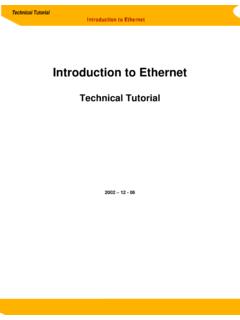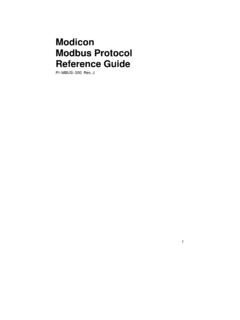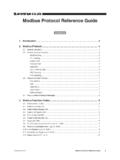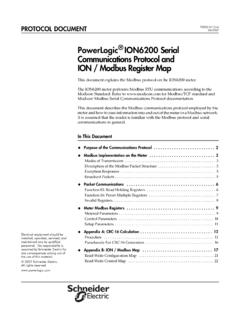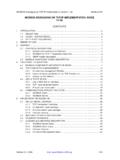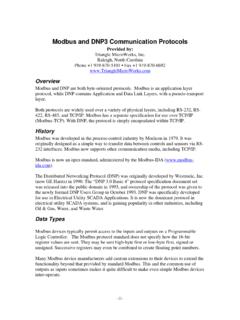Transcription of Introduction to MODBUS - INTEA Automatizacija
1 Introduction to MODBUS Technical Tutorial 2002 12 - 06 Technical TutorialIntroduction to MODBUS 2 Table of Contents 1: Introduction 2: Communication between MODBUS devices 3: MODBUS REGISTER MAP 4: Serial Transmission Modes of MODBUS networks ASCII Mode RTU Mode 5: MODBUS MESSAGE FRAMING ASCII Mode Message Frames RTU Mode Message Frames 6: MODBUS ADDRESSES 7: MODBUS FUNCTIONS 8: MODBUS DATA FIELD 9: MODBUS ERROR CHECKING Parity Checking Frame checking 10: MODBUS EXCEPTIONS 11: MODBUS /TCP 12: MODBUS /TCP and Sena Products 13: Conclusion Technical TutorialIntroduction to MODBUS 31. Introduction MODBUS Protocol is a messaging structure developed by Modicon in 1979, used to establish master-slave/client-server communication between intelligent devices.
2 It is a de facto standard, truly open and the most widely used network protocol in the industrial manufacturing environment. The MODBUS protocol provides an industry standard method that MODBUS devices use for parsing messages. 2. Communication between MODBUS devices MODBUS devices communicate using a master-slave technique in which only one device (the master) can initiate transactions (called queries). The other devices (slaves) respond by supplying the requested data to the master, or by taking the action requested in the query. A slave is any peripheral device (I/O transducer, valve, network drive, or other measuring device), which processes information and sends its output to the master using MODBUS . Masters can address individual slaves, or can initiate a broadcast message to all slaves.
3 Slaves return a response to all queries addressed to them individually, but do not respond to broadcast queries 3. MODBUS REGISTER MAP MODBUS devices usually include a Register Map. MODBUS functions operate on register map registers to monitor, configure, and control module I/O. You should refer to the register map for your device to gain a better understanding of its operation. 4. Serial Transmission Modes of MODBUS networks The transmission mode defines the bit contents of the message bytes transmitted along the network, and how the message information is to be packed into the message stream and decoded. Standard MODBUS networks employ one of two types of transmission modes: ASCII Mode RTU Mode. The mode of transmission is usually selected along with other serial port communication parameters (baud rate, parity, etc.)
4 As part of the device configuration. Technical TutorialIntroduction to MODBUS ASCII Transmission Mode In the ASCII Transmission Mode (American Standard Code for Information Interchange), each character byte in a message is sent as 2 ASCII characters. This mode allows time intervals of up to a second between characters during transmission without generating errors. RTU (Remote Terminal Unit) Transmission Mode In RTU (Remote Terminal Unit) Mode, each 8-bit message byte contains two 4-bit hexadecimal characters, and the message is transmitted in a continuous stream. The greater effective character density increases throughput over ASCII mode at the same baud rate. 5. MODBUS MESSAGE FRAMING A message frame is used to mark the beginning and ending point of a message allowing the receiving device to determine which device is being addressed and to know when the message is completed.
5 It also allows partial messages to be detected and errors flagged as a result. A MODBUS message is placed in a message frame by the transmitting device. Each word of this message (including the frame) is also placed in a data frame that appends a start bit, stop bit, and parity bit. In ASCII mode, the word size is 7 bits, while in RTU mode; the word size is 8 bits. Thus, every 8 bits of an RTU message is effectively 11 bits when accounting for the start, stop, and parity bits of the data frame Do not confuse the message frame with the data frame of a single byte (RTU Mode) or 7-bit character (ASCII Mode). The structure of the data frame depends on the transmission mode (ASCII or RTU). Note that on some other network types and on MODBUS Plus, the network protocol handles the framing of messages and uses start and end delimiters specific to the network.
6 Technical TutorialIntroduction to MODBUS 5 ASCII Mode Message Frames ASCII Mode messages start with a colon character ":" (ASCII 3AH) and end with a carriage return-line feed pair of characters (CRLF, ASCII 0DH & 0AH). The only allowable characters for all other fields are hexadecimal 0-9 & A-F. Recall that it only takes 7 significant bits to represent an ASCII character. Likewise, the MODBUS ASCII Mode data byte' or character is only 7 bits long. For ASCII Mode transmission, each character requires 7 data bits. Thus, each character is 10 bits when accounting for the start bit, parity bit, and stop bit of the data frame. In ASCII Mode, all network devices continuously monitor the network for the start of message' colon (:) character. When it is received, every network device decodes the next field to determine if it is the addressed device.
7 RTU Mode Message Frames RTU mode messages start with a silent interval of at least character times implemented as a multiple of character times at the baud rate being used on the network. The first field transmitted is the device address. The allowable characters transmitted for all fields are hexadecimal values 0-9, A-F. A networked device continuously monitors the network, including the silent intervals, and when the first field is received (the address) after a silent interval of at least character times, the device decodes it to determine if it is the addressed device. Following the last character transmitted, a similar silent interval of character times marks the end of the message and a new message can begin after this interval.
8 The entire message must be transmitted as a continuous stream. If a silent interval of more than character times occurs before completion of the frame (not a continuous stream), the receiving device flushes the incomplete message and assumes the next byte will be the address field of a new message. In similar fashion, if a new message begins earlier than character times following a previous message, the receiving device assumes it is a continuation of the previous message. This will generate an error, as the value in the final CRC field will not be valid for the combined messages. Technical TutorialIntroduction to MODBUS 66. MODBUS ADDRESSES The master device addresses a specific slave device by placing the 8-bit slave address in the address field of the message (RTU Mode).
9 The address field of the message frame contains two characters (in ASCII mode), or 8 binary bits (in RTU Mode). Valid addresses are from 1-247. When the slave responds, it places its own address in this field of its response to let the master know which slave is responding. 7. MODBUS FUNCTIONS The function code field of the message frame will contain two characters (in ASCII mode), or 8 binary bits (in RTU Mode) that tell the slave what kind of action to take. Valid function codes are from 1-255, but not all codes will apply to a module and some codes are reserved for future use. 8. MODBUS DATA FIELD The data field provides the slave with any additional information required by the slave to complete the action specified by the function code.
10 The data is formed from a multiple of character bytes (a pair of ASCII characters in ASCII Mode), or a multiple of two hex digits in RTU mode, in range 00H-FFH. The data field typically includes register addresses; count values, and written data. If no error occurs, the data field of a response from a slave will return the requested data. If an error occurs, the data field returns an exception code that the master's application software can use to determine the next action to take. Technical TutorialIntroduction to MODBUS 79. MODBUS ERROR CHECKING MODBUS networks employ two methods of error checking: parity checking 1. Parity checking of the data character frame (even, odd, or no parity) 2. Frame checking within the message frame (Cyclical Redundancy Check in RTU Mode, or Longitudinal Redundancy Check in ASCII Mode).

